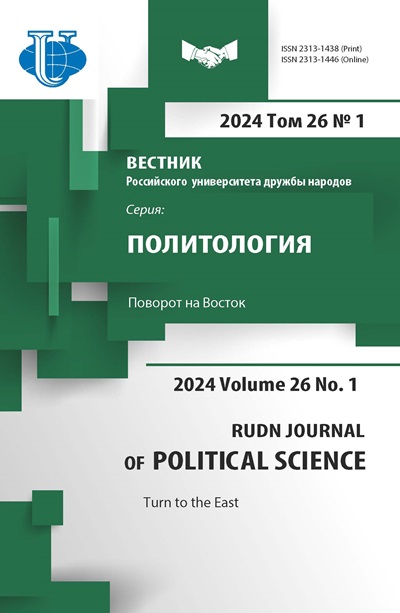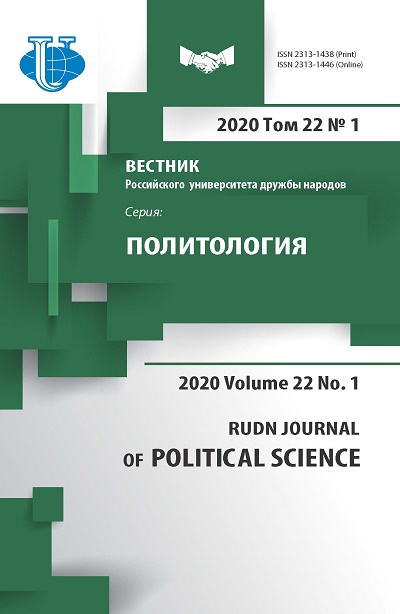Iran’s Soft Power Tools in Kyrgyzstan
- Authors: Garbuzarova E.G.1
-
Affiliations:
- Kyrgyz-Russian Slavic University
- Issue: Vol 22, No 1 (2020)
- Pages: 22-31
- Section: CONTEMPORARY POLITICS OF IRAN
- URL: https://journals.rudn.ru/political-science/article/view/23274
- DOI: https://doi.org/10.22363/2313-1438-2020-22-1-22-31
Cite item
Full Text
Abstract
The article examines the use of “soft power” tools used by Iran in relation to Kyrgyzstan. The analysis of the evolving fundamental concepts of Iranian foreign policy in Central Asia allowed us to trace a shift in the Islamic Republic’s international priorities in the region. Objective logic prompted the Iranian leadership to move from “exporting the Islamic revolution” to the pragmatic model of pursuing its national interests. Iran has consecutively incorporated soft power tools into its foreign policy activities in Central Asia. Given the pressure from the sanctions imposed by the United States, Iran attaches particular importance to improving the effectiveness of its soft power in order to expand cooperation horizons with the outside world. By the end of the 20th century, Iran’s leadership had already laid the foundations of its cultural diplomacy in the region, which mainly served to promote influence through the export of cultural values. The Iranian approach to soft power in world politics is based on the principles of reciprocity between different civilizations and peaceful coexistence of all countries and peoples. Through the Persian language, philosophy, literature and poetry, Iran influences the population of the Central Asian region, mainly the peoples sharing certain features with the Turkic-speaking world. Iran’s cultural and educational activities in Kyrgyzstan have demonstrated noticeable dynamics: the spread of soft power of the Islamic Republic of Iran in Kyrgyzstan is carried out through cultural institutions and educational projects. Despite the fact that Kyrgyzstan is culturally more inclined towards the Turkic world, the experience shows that Iran’s cultural values also find support among the population of the republic.
Keywords
About the authors
Elena G. Garbuzarova
Kyrgyz-Russian Slavic University
Author for correspondence.
Email: play_elenag@mail.ru
PhD in History, Associate Professor of Political Science Department
44 Kievskaya Str., Bishkek, Kyrgyzstan, 720000References
- Neymark M. A. “Soft Power” in World Politics. Moscow; 2017. 272 p. (In Russ.).
- Neymark M.A. Before Strategic Choice: New Imperatives of World Politics. Problems of Post-Soviet Space. 2017; 4 (30): 184–201 (In Russ.).
- Mesamed V. Iran: 10 Years in Post-Soviet Central Asia. Available from: https://cac.org/journal/2002/journal_rus/cac-01/04.mesru.shtml. Accessed: 11.10.2019 (In Russ.).
- Khandogin K. Evolution of the Islamic Revolution Export Concept in the Context of Iran’s Foreign Policy in the 1990s. Vlast’. 2011; 11: 167–169 (In Russ.).
- Mesamed V. Iran’s Policy in Central Asia: Illusions and Reality. Zona.kz. 19.10.2001. Available from: https://zonakz.net/2001/10/19. Accessed: 11.10.2019 (In Russ.).
- Peyrouse S. Iran’s Growing Role in Central Asia? Geopolitical, Economic and Political Income Statement. AlJazeera Centre for Studies. 04.01.2014. Available from: http://studies.aljazeera.net/ en/dossiers/2014/04/2014416940377354.html. Accessed: 11.10.2019.
- Torin A. The Islamic revolution in Iran and Contemporary Foreign Politics of the East. International Affairs. 16.02.2017. Available from: https://interaffairs.ru/news/show/ 16923?show_desktop_mode=true. Accessed: 11.10.2019 (In Russ.).
- Klyashtorina V.B. Iranian Concept of Dialogue of Cultures: Scientific and Political Aspect. Iran: Dialogue of Civilizations. Conference proceedings. Moscow: Ant; 2003. 112 p. (In Russ.).
- Kurylev K.P., Nikulin M.A., Goncharova A.A. “Soft power” of Cultural Diplomacy of the Islamic Republic of Iran. Vestnik MGOU. Series: History and Political Science. 2017; 2; 46–55 (In Russ.).
- Khatami Arrives in Bishkek. Centers of Trade, Iranian Studies and Islamic Studies Will be Opened. CentrAsia. 28.04.2002. Available from: https://centrasia.org/newsA.php?st= 1019941920. Accessed: 11.10.2019 (In Russ.).
- Parkhomchik L. Modification of Iran's Foreign Policy Orientation in Central Asia. CABAR. 25.08.2016. Available from: https://cabar.asia/en/lidiya-parkhomchik-modification-of-irans-foreign-policy-orientation-in-central-asia. Accessed: 11.10.2019.
- Zvyagelskaya I. In Search of a Fulcrum: Iran in Central Asia. RIAC. 12.11.2014. Available from: https://russiancouncil.ru/analytics-and-comments/analytics/v-poiskakh-tochki-oporyiran-v-tsentralnoy-azii/. Accessed: 11.10.2019 (In Russ.).
- Mutov S.A. Central Asia in the Politics of the Muslim World. The author's abstract of a PhD thesis in political sciences. Moscow; 2011. 24 p. (In Russ.).
- Kobischanov Yu. Shia Community of Peoples. NG religions. 07.09.2016. Available from: http://www.ng.ru/ng_religii/2016-09-07/6_shiit.html. Accessed: 11.10.2019 (In Russ.).
- Malysheva D. International-political Interaction of Central Asian States with Turkey and Iran. Russia and the New States of Eurasia. 2017; 3 (36): 46–58 (In Russ.).
- Culture and arts exchange program between the Ministry of culture, information and tourism of the Kyrgyz Republic and the Ministry of culture and Islamic orientation of the Islamic Republic of Iran for 2017-2020. Available from: https://online.zakon.kz/Document/?doc_id= 35125451#pos=0;20. Accessed: 11.10.2019 (In Russ.).
- Rouhani: We Have a Common Civilization with the Kyrgyz People. Sputnik Kyrgyzstan. 20.05.2017. Available from: https://ru.sputnik.kg/politics/20161223/1030934659/atambaevi-rouhani-vstretilis-v-bishkeke.html. Accessed: 11.10.2019 (In Russ.).
- Formation of a movement to return to Islam in Kyrgyzstan. International Quran News Agency (IQNA). Available from: http://iqnanews.ru. Accessed: 11.10.2019 (In Russ.).
- Iran News portal. Available from: https://iran.kg/index.php?action_skin_change= yes&skin_name=far-far. Accessed: 11.10.2019 (In Russ.).
















